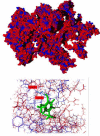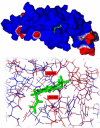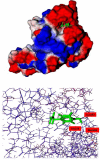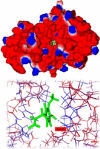Cinnamaldehyde and eugenol change the expression folds of AKT1 and DKC1 genes and decrease the telomere length of human adipose-derived stem cells (hASCs): An experimental and in silico study
- PMID: 28392905
- PMCID: PMC5378970
- DOI: 10.22038/IJBMS.2017.8362
Cinnamaldehyde and eugenol change the expression folds of AKT1 and DKC1 genes and decrease the telomere length of human adipose-derived stem cells (hASCs): An experimental and in silico study
Abstract
Objectives: To investigate the effect of cinnamaldehyde and eugenol on the telomere-dependent senescence of stem cells. In addition, to search the probable targets of mentioned phytochemicals between human telomere interacting proteins (TIPs) using in silico studies.
Materials and methods: Human adipose derived stem cells (hASCs) were studied under treatments with 2.5 µM/ml cinnamaldehyde, 0.1 µg/ml eugenol, 0.01% DMSO or any additive. The expression of TERT, AKT1 and DKC1 genes and the telomere length were assessed over 48-hr treatment. In addition, docking study was conducted to show probable ways through which phytochemicals interact with TIPs.
Results: Treated and untreated hASCs had undetectable TERT expression, but they had different AKT1 and DKC1 expression levels (CI=0.95; P<0.05). The telomere lengths were reduced in phytochemicals treated with hASCs when compared with the untreated cells (P<0.05). Docking results showed that the TIPs might be the proper targets for cinnamaldehyde and eugenol. Data mining showed there are many targets for cinnamaldehyde and eugenol in the intracellular environment.
Conclusion: The general effect of cinnamaldehyde and eugenol is their induction of stem cell senescence. Therefore, they could be applicable as chemo-preventive or antineoplastic agents.
Keywords: Aging; Cinnamaldehyde; Eugenol; Stem cells; Telomerase; Telomere.
Figures
















Similar articles
-
The effects of cinnamaldehyde and eugenol on human adipose-derived mesenchymal stem cells viability, growth and differentiation: a cheminformatics and in vitro study.Avicenna J Phytomed. 2016 Nov-Dec;6(6):643-657. Avicenna J Phytomed. 2016. PMID: 28078245 Free PMC article.
-
Human adipose tissue-derived stem cells cultured in xeno-free culture condition enhance c-MYC expression increasing proliferation but bypassing spontaneous cell transformation.Stem Cell Res Ther. 2015 Apr 14;6(1):76. doi: 10.1186/s13287-015-0030-4. Stem Cell Res Ther. 2015. PMID: 25889298 Free PMC article.
-
[Preliminary evaluation and mechanism of adipose-derived stem cell transplantation from allogenic diabetic rats in the treatment of diabetic rat wounds].Zhonghua Shao Shang Za Zhi. 2019 Sep 20;35(9):645-654. doi: 10.3760/cma.j.issn.1009-2587.2019.09.002. Zhonghua Shao Shang Za Zhi. 2019. PMID: 31594182 Chinese.
-
Tissue formation and tissue engineering through host cell recruitment or a potential injectable cell-based biocomposite with replicative potential: Molecular mechanisms controlling cellular senescence and the involvement of controlled transient telomerase activation therapies.J Biomed Mater Res A. 2015 Dec;103(12):3993-4023. doi: 10.1002/jbm.a.35515. Epub 2015 Aug 14. J Biomed Mater Res A. 2015. PMID: 26034007 Review.
-
Telomerase activity and telomere on stem progeny senescence.Biomed Pharmacother. 2018 Jun;102:9-17. doi: 10.1016/j.biopha.2018.02.073. Epub 2018 Mar 14. Biomed Pharmacother. 2018. PMID: 29547744 Review.
Cited by
-
Deciphering the Anticancer Arsenal of Piper longum: Network Pharmacology and Molecular Docking Unveil Phytochemical Targets Against Lung Cancer.Int J Med Sci. 2024 Jul 22;21(10):1915-1928. doi: 10.7150/ijms.98393. eCollection 2024. Int J Med Sci. 2024. PMID: 39113883 Free PMC article.
-
Ethnomedicinal uses of Indian spices used for cancer treatment: A treatise on structure-activity relationship and signaling pathways.Curr Res Food Sci. 2022 Oct 11;5:1845-1872. doi: 10.1016/j.crfs.2022.10.005. eCollection 2022. Curr Res Food Sci. 2022. PMID: 36276240 Free PMC article. Review.
-
Natural products regulate mitochondrial function in cognitive dysfunction-A scoping review.Front Pharmacol. 2023 Mar 7;14:1091879. doi: 10.3389/fphar.2023.1091879. eCollection 2023. Front Pharmacol. 2023. PMID: 36959855 Free PMC article.
References
-
- Flores I, Blasco MA. The role of telomeres and telomerase in stem cell aging. FEBS Lett. 2010;584:3826–3830. - PubMed
-
- Wong C-C, Li H-B, Cheng K-W, Chen F. A systematic survey of antioxidant activity of 30 Chinese medicinal plants using the ferric reducing antioxidant power assay. Food Chem. 2006;97:705–711.
-
- Zaveri NT. Green tea and its polyphenolic catechins: Medicinal uses in cancer and noncancer applications. Life Sci. 2006;78:2073–2080. - PubMed
-
- Ho YS, So KF, Chang RCC. Anti-aging herbal medicine—How and why can they be used in aging-associated neurodegenerative diseases? Ageing Res Rev. 2010;9:354–362. - PubMed
-
- Ogata M, Hoshi M, Urano S, Endo T. Antioxidant activity of eugenol and related monomeric and dimeric compounds. Chem Pharm Bull. 2000;48:1467–1469. - PubMed
LinkOut - more resources
Full Text Sources
Miscellaneous
